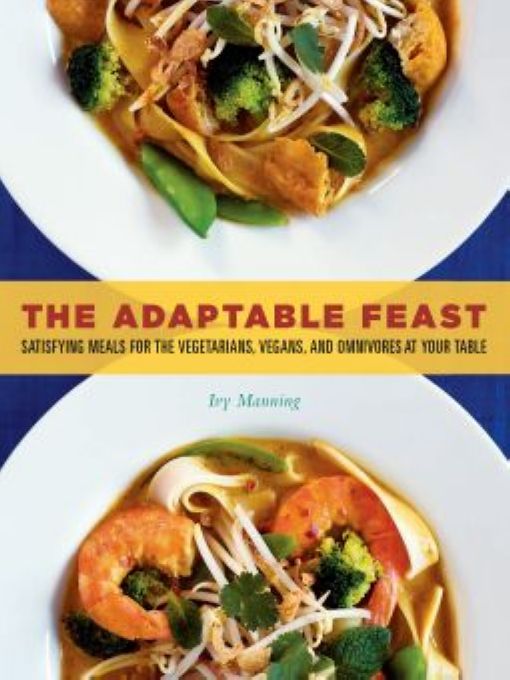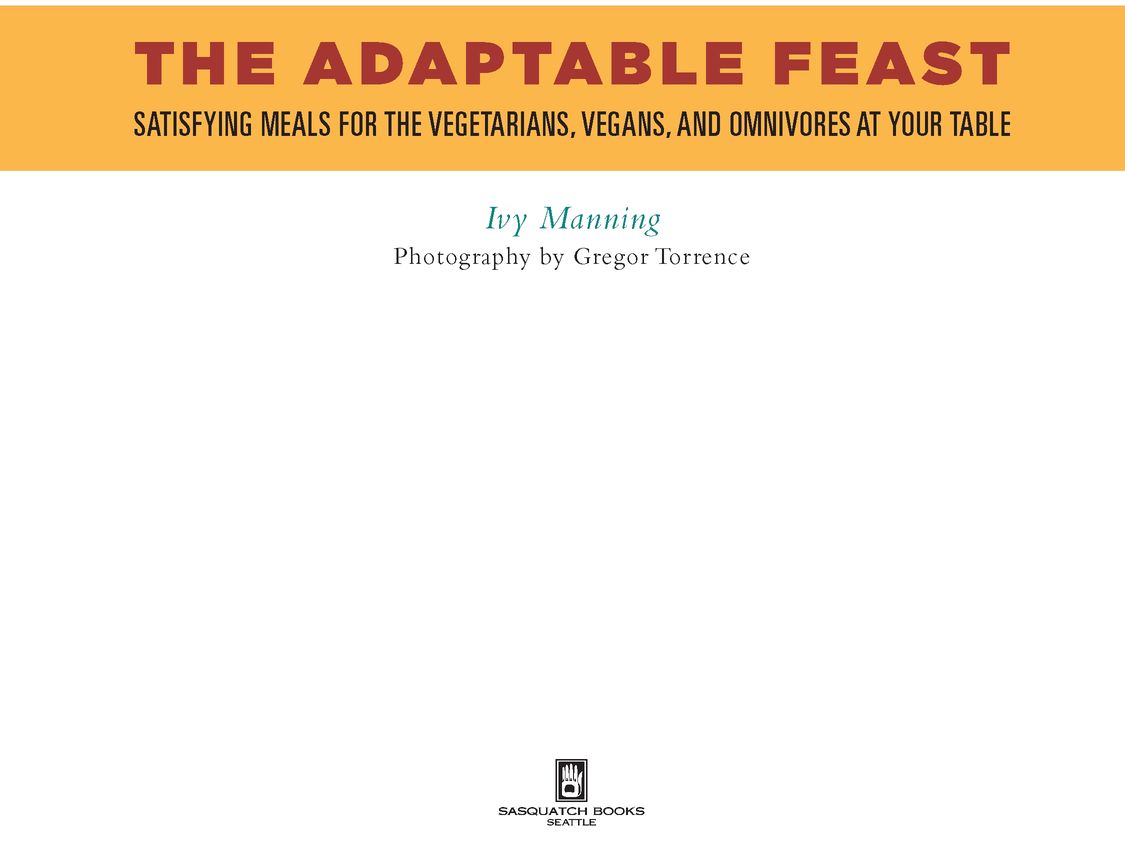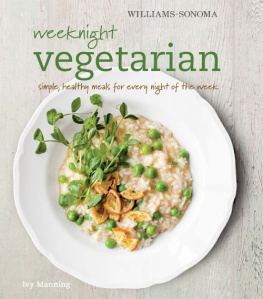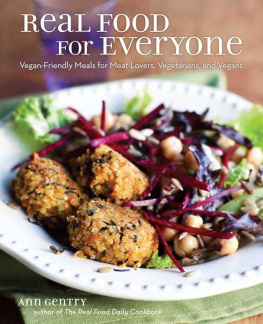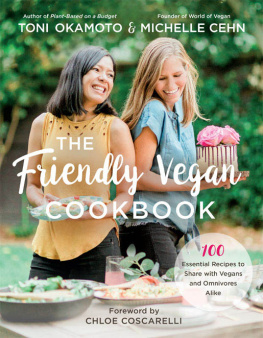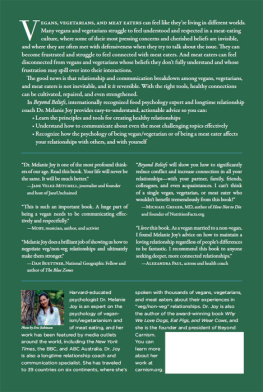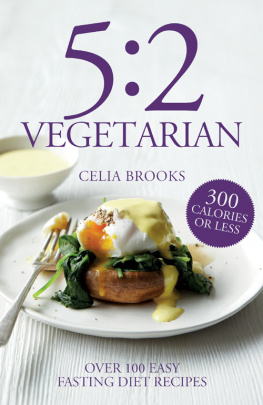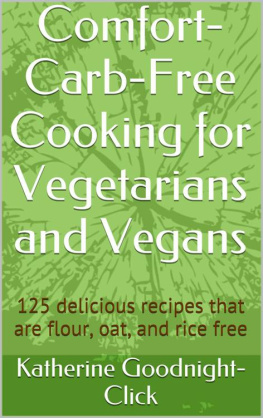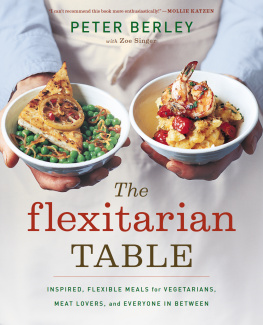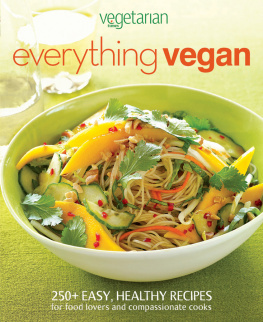Table of Contents
This book is dedicated to Gregor, who challenges me to create mixed-diet meals every day, and to Alice B. Toklas, my eager recipe taster and the smartest dog in the world. May she be feasting in her next life.
ACKNOWLEDGMENTS
The amount of work it took to reinvent recipes for the mixed-diet format and edit them to create clean, understandable sets of instructions was a Herculean task. Id like to thank my editor Gary Luke for trusting in my idea and project editor Rachelle Long for being patient, funny, and very organized. Thanks also to Andy Manning and all of the other mixed-diet cooks who were eager to try my recipes and give me honest feedback. And finally, a heartfelt thank-you to my husband, Gregor Torrence, who has stuck to his vegetarian guns all this time.
GETTING STARTED IN A MIXED-DIET KITCHEN
Ethical omnivore, vegetarian, flexitarian, pescatarian, vegan. Our vocabulary is quickly evolving to describe the way Americans are changing their eating habits for reasons of health, ethics, and the environment.With all these dietary variations, its common for families to have vegetarians or vegans in their ranks while the rest of the family eats meat. So how do you cook for everyone in a mixed-diet family without making two separate meals every night or shortchanging vegetarians or vegans by serving them nothing but tofu dogs or side dishes?
I have learned from personal experience just how challenging these questions can be. When I met my vegetarian husband, friends said it would never work. You are far too good at cooking meat, they scoffed. Youll have him eating your barbecued ribs in no time, or youll go your separate ways. I must admit that in the beginning of our relationship, I urged Mr. Tofu to cave to my meat-eating ways. Eventually I realized that I needed to respect his dietary choices, so I switched to cooking vegetarian food for both of us, but I often missed eating meat. Finally, I began tinkering with dishes I had been cooking for years, making some of each dish vegetarian while still adding meat to my portion.
Its been five years now, and Mr. Tofu and I are married (against some friends bets), and cooking mixed-diet meals is now second nature to me. My husband appreciates that I no longer plead with him to try a bit of chicken, and I love that I can have my old familiar favorites with a bit of sustainably raised meat in them. Plus, Ive become more open-minded and have learned to love tofu, seitan, and other vegetarian proteins. Were living proof that harmony can happen; it just takes an open mind and an adventurous spirit in the kitchen to make it work.
The Adaptable Feast will show you how to cook for omnivores, vegetarians, and vegans on every occasion, whether its a weeknight quick fix for your immediate family, cocktail nibbles for a group, or a special-occasion holiday meal when you want everyone to feel welcome, no matter their dining preference. This book will show you how to cook one meal by preparing a portion with tasty protein-rich meat alternatives like tofu, seitan, or beans and the rest with sustainably raised meat or seafood. With more than eighty-five recipes ranging from familiar favorites like Red Chile Enchiladas with Chicken or Tempeh (page 118) to exciting Asian fare like Pad Thai with Shrimp or Tofu (page 150), this book will show you how to cook delicious, nutritionally balanced meals for the whole family without dirtying every pan in the kitchen or discounting anyones diet.
Whether you are a curious omnivore who would like to test the vegetarian or vegan waters without jumping in completely, or you are the designated cook in a mixed-diet family who is tired of doing double duty, this book will launch you into a world where meat eaters, vegetarians, and vegans can sit together and share scrumptious meals in harmony.
A PLEA FOR RESPONSIBLE OMNIVORISM
What we choose to eat has environmental, social, and economic impact. If you choose to eat meat, I urge you to be mindful of where it comes from. Animals that are raised in inhumane factory farms are not only subjected to undeserved cruelty but are also less safe and less savory to eat. Please seek out beef and lamb from animals that are grass fed, genuinely free range and organic poultry, and pigs that are raised humanely. Buy sustainable fish that are caught only from fisheries deemed healthy. (See Recommended Reading and Media for informative Web sites that can help you make smart choices when buying meat and fish.) Its not only vegetarians and vegans who should be mindful of what they eat; its every-vore.
THE ADAPTABLE FEAST METHOD
The recipes in this book follow the same conventions found in standard recipes, with one difference. At some point in the instructions while you are chopping, stirring, and prepping each meal, youll come across a step or steps marked VEGETARIAN. The instructions that follow (set in bold type) will be specifically for the vegetarian or vegan portion of the recipe so you will know when you are cooking that something should remain meat-free. At times this section can be as simple as setting aside a vegetarian portion of the recipe at the end of cooking before adding meat to the remaining dish, as with recipes like Fried Green Tomatoes (and Sometimes Bacon) with Smokey Blue Cheese (page 25). In other recipes the meal is made up of individual servings, like the Antipasto Calzones (page 67), so while most of the servings are made with Italian sausage (for instance), the rest is made with a tasty vegetarian protein alternative. In other recipes, the basis of the dish is the same for both omnivores and vegetarians or vegans, but it is separated into two portions before incorporating the proteins. In the recipe for Shepherds Pie (page 129), for example, a vegetable-based stew is divided into two baking dishes. Soy crumbles are added to one dish and ground lamb is added to the other.
If there happens to be a vegan in your ranks, never fear! Over half of the vegetarian recipe variations in this book also happen to be vegan. The vegan recipes are clearly marked with a V beside the recipe title. Additionally, wherever possible, I have included a Vegan Variation note at the end of a recipe where a few changes to the existing instructions can make the vegetarian portion of the recipe suitable for vegans.
The Adaptable Feast method may seem a bit foreign at first, but after you try a few recipes, I am sure you will find it almost as simple as cooking single-diet meals, and with time youll be able to apply the same adaptable principles to your own recipes.
TRANSITIONING TO MIXED-DIET COOKING
Beyond the tempting recipes, Ive also included sections to help you transition all your cooking to the mixed-diet format.The Alternative Protein Primer (see page xvii) demystifies the world of meat alternatives so you can confidently add everything from edamame to tempeh to your cooking. A section on umami (see page xii) explains how to use ingredients naturally high in glutamates to make meals taste more satisfying, meat or no. The Special Occasions chapter provides do-ahead vegetarian alternatives for those who wont be partaking of the Thanksgiving turkey, Christmas roast, or St. Patricks Day corned beef, and the Basics chapter helps with tricky substitutions for common meat-based ingredients like chicken stock and fish sauce.

